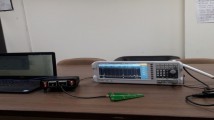Abstract
A modified path loss prediction model for deep fading area is presented and compared with standard indoor path loss model. An academician perspective, it may not be feasible to design a network for its maximum capacity & coverage under deep fading environment. The above facts reveals us to carry out real time analysis of network using advance set up and predict minimum detectable signal in deep fading area. In this paper, monitoring of signal at different frequency and power under deep fading condition is carried out to check and access the reality of signal variation. The temporal variation of signal is recorded continuously to check the minimum availability of signalfor mathematical analysis. The statistical analysis on recorded data provides large variation in standard deviation (13.16 to 17.25 dB) and the path loss exponent tends to a new value of 4.8. The received signal strength for LTE network goes beyond − 74 to − 103 dBm.Path loss at different frequency, power and distance is calculated using ITU model, Log Distance model and new model is proposed for fading area. The large variation in path loss (9 to 283 dB) for different networks is plotted for fading area under study.The improvement of signal strength was observed slightly by 10 dBm when base station antenna was down tilted by − 20. The change in signal strength after down tilting the antenna is also recorded and presented. Such small increment in signal strength may allow network to provide better connectivity in fading area with good quality of service (QoS).










Similar content being viewed by others
References
3rd Generation Partnership Project; Technical Speci_cation Group Ser- vices and System Aspects; Architecture Enhancement for Non-3GPP Accesses (Release 14), document 3GPP TS 23.402 V14.3.0, 2017.
3rd Generation Partnership Project; Technical Speci_cation Group Radio Access Network; Evolved Universal Terrestrial Radio Access (E-UTRA) and Evolved Universal Terrestrial Radio Access Network (E-UTRAN); Overall Description; Stage 2 (Release 14),document 3GPP TS 36.300 V14.1.0, 2016.
3rd Generation Partnership Project; Technical Speci_cation Group Ser- vices and System Aspects; 3GPP System Architecture Evolution (SAE); Security Architecture (Release 14), document 3GPP TS 33.401 V14.2.0,2017.
Foschini, G. J. (1996). Layered space-time architecture for wireless communication in a fading environment when using multi-element antennas. Bell Labs Technical Journal, 1(2), 41–59.
Siomina, I., & Yuan, D. (2012). Analysis of cell load coupling for LTE network planning and optimization. IEEE Transactions on Wireless Communications, 11(6), 2287–2297.
Lee, D., Zhou, S., Zhong, X., Niu,Z., Zhou, X., and Zhang, H., (2018) “Spatial modeling of the traffic density in cellular networks. IEEE Wireless Communication, 21(1), 80–88, 188 IEEE/ACM Transactions On Networking, 26(1).
D. González, G., and Hämäläinen, J., (2015). Planning and optimization of cellular networks through centroidal Voronoi tessellations. In Proceedings of IEEE 82nd Vehicular Technology Conference (VTC) (pp. 1–2).
Jaber, M., Dawy, Z., Akl, N., & Yaacoub, E. (2016). Tutorial on LTE/LTEA cellular network dimensioning using iterative statistical analysis. IEEE Communication Surveys Tutorial, 18(2), 1355–1383. 2nd Quart.
Wang, S., & Ran, C. (2016). Rethinking cellular network planning and optimization. IEEE Wireless Communication, 23(2), 118–125.
Wang, C. X. (2014). Cellular architecture and key technologies for 5G Wireless communication networks. IEEE Communication Magazine, 52(2), 122–130.
Ge, X. (2014). 5G wireless backhaul networks: challenges and research advances. IEEE Network, 28(6), 6–11.
Soret, B. (2015). Interference coordination for dense wireless networks. IEEE Communication Magazine, 53(1), 102–109.
Dehos, C. (2014). Millimeter-wave access and back-hauling: the solution to the exponential data traffic increase in 5G mobile communications systems? IEEE Communication Magazine, 52(9), 88–95.
Mousavi, A., & Baraniuk, R.G., (2017). Learning to Invert: Signal Recovery via Deep Convolutional Networks. In Proceedings of IEEE Int’l. Confeerence Acoustics Speech Signal Process. (ICASSP’17) (pp. 2272–76).
Al-Hourani, A., Kandeepan, S., Jamalipour, S.A., (2014) Modeling air-to-ground path loss for low altitude platforms in urban environments. In Proceedings of GLOBECOM Symposium Sel. Areas Communication. Satellite Space Communication
Holis, J., & Pechac, P. (2008). Elevation dependent shadowing model for mobile communications via high altitude platforms in built-up areas. IEEE Transactions on Antennas and Propagation, 56(4), 1078–1084.
Pagano, S., Peirani, S., & Valle, M. (2015). Indoor ranging and localization algorithm based on received signal strength indicator using statistic parameters for wireless sensor networks. IET Wireless Sensor Systems, 5(5), 243–249.
Yadav, P., & Agrawal, R. (2019). Network selection for maximum coverage using regression analysis in deep fading environment. Wireless Personal Communications, 106(3), 1057–1074.
Sehgal, A., Agrawal, R., Bhardwaj, R., & Singh, K. K. (2020). Reliability analysis of wireless link for IOT applications under shadow-fading conditions. Procedia Computer Science, 167, 1515–1523.
Kadamus, G., & Langer, M. (2018). Measurements and statistical analysis for assessment of availability of mobile network services. Journal of Telecommunications and Information Technology, 2, 48–52.
Kumar, R., Tripathi, S., & Agrawal, R. (2020). An analysis and comparison of security protocols on wireless sensor networks (WSN). Lecture Notes in Networks and Systems, 82, 3–21.
Author information
Authors and Affiliations
Corresponding author
Additional information
Publisher's Note
Springer Nature remains neutral with regard to jurisdictional claims in published maps and institutional affiliations.
Rights and permissions
About this article
Cite this article
Sharma, S., Singh, B. Network Planning in Deep Fading Area is a Research Challenge. Wireless Pers Commun 117, 2273–2284 (2021). https://doi.org/10.1007/s11277-020-07971-2
Published:
Issue Date:
DOI: https://doi.org/10.1007/s11277-020-07971-2




